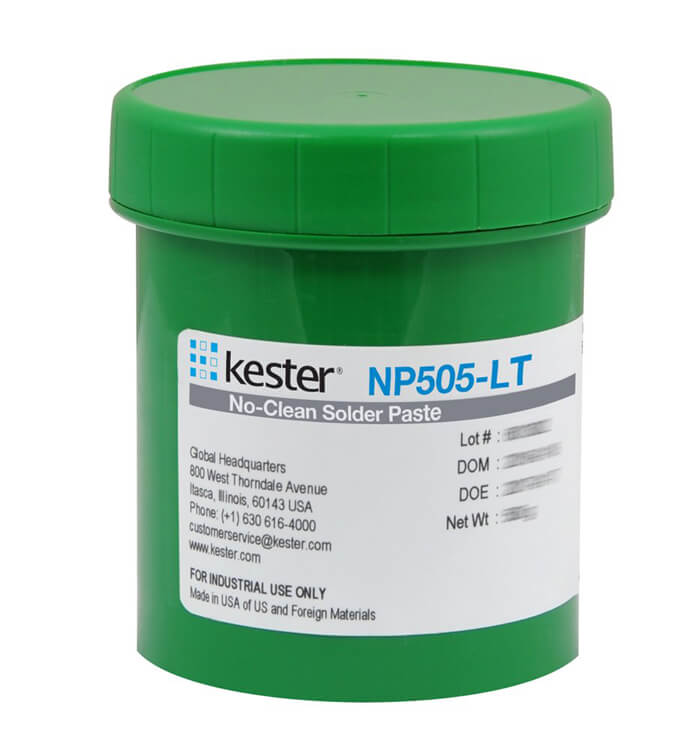Home > SMT Peripheral Equipment
Sn42Bi57Ag1 Solder Paste NP505-LT
Products description


Sn42Bi57Ag1 Solder Paste NP505-LT
Sn42Bi57Ag1 Solder Paste NNP505-LT is a no-clean, Pb-free, zero-halogen solder paste for assemblies that have temperature sensitive substrates and components. Warping is becoming more evident with the trend towards complex boards and the trend of using thinner and larger packages and boards. The defects caused by the warpage may decrease board reliability and increase in rework. NP505-LT is designed to reduce warpage inherent to board-to-package.
Alloy: Sn42Bi57Ag1
Powder Size: 4
Type: No-Clean
Halogen Content: Zero-Halogen
Lead Content: Lead-Free
Description: NP505-LT Sn42Bi57Ag1 T4 89.5% 500g JAR
Process: Screen/Stencil Printing
There are various grades of solder paste and the required type can be selected to fit in with the PCB assembly process used. The solder paste is graded according to the size of the small solder balls. As they cannot be exactly graded, the different types have a band of solder ball sizes between which 80% of the minute solder balls fall.
| IPC TYPE DESIGNATION | PARTICLE SIZE (ΜM) * |
|---|---|
| Type 1 | 75 - 150 |
| Type 2 | 45 - 75 |
| Type 3 | 25 - 45 |
| Type 4 | 20 - 38 |
| Type 5 | 10 - 25 |
| Type 6 | 5 - 15 |
| Type 7 | 2 - 11 |
| Type 8 | 2 - 8 |
* 80% minimum between the stated sizes
Solder can also be categorised according to the type of flux used:
In order to ensure that the solder paste is suitable for proving the highest performance for PCB assembly it is necessary to ensure that it maintains the required properties. To achieve this it is imperative that the solder paste is stored correctly. It should always be stored in an airtight container to prevent oxidation. The very large surface area of the minute solder spheres, means that oxidation can present a very great problem.
Additionally, the solder must be stored at low temperatures. Not only does this reduce the rate of any oxidation there may be, but it also reduces the rate at which the flux degrades. While a low temperature is imperative, it should not be stored at a temperature below freezing.
In view of the way in which solder paste can degrade, it also has a defined shelf life and it should not be used after its end date. If old solder paste is used there is a distinct risk of a much higher defect rate, and the cost of any rework incurred would be well beyond the cost of replacing the solder paste.
When solder paste is used in mass PCB assembly as well as prototype PCB assembly there are a number of stages that are undertaken. First solder paste is applied to the printed circuit boards. The solder paste is only applied to the areas where solder is required. This is achieved using a solder paste stencil that only allows the solder paste through in certain areas.
There are many ways of achieving this, but typically a stencil is placed over the board, and the paste is applied though this, ensuring that the required amount is applied - too little and the joints will have sufficient solder - too much and the joints will be too large and there may be the possibility of poor joints and even shorts between adjacent pads, etc.
Once the solder paste has been applied to the printed circuit board, it is then passed into the pick and place machine where the components are added. The solder paste has sufficient tension that it holds the components in place. However care should be taken not to knock the board at this stage otherwise the components may move of fall off. Additionally the board should be soldered within a few hours of being placed, otherwise the solder paste may deteriorate.
Keywords:
SMT Peripheral Equipment, PCB Loader, PCB Unloader, SMT PCB Conveyor, SMT PCB Cleaning Machine, DIP Insert Line, SMT NG/OK Unloader, SMT Shuttle Conveyor.




Contact: Mr Tommy
Phone: +86 13691605420
Tel: +86 -755-85225569
Email: tommy@flason-smt.com
Add: 94#,Guangtian Road,Songgang Street,Bao an District Shenzhen China